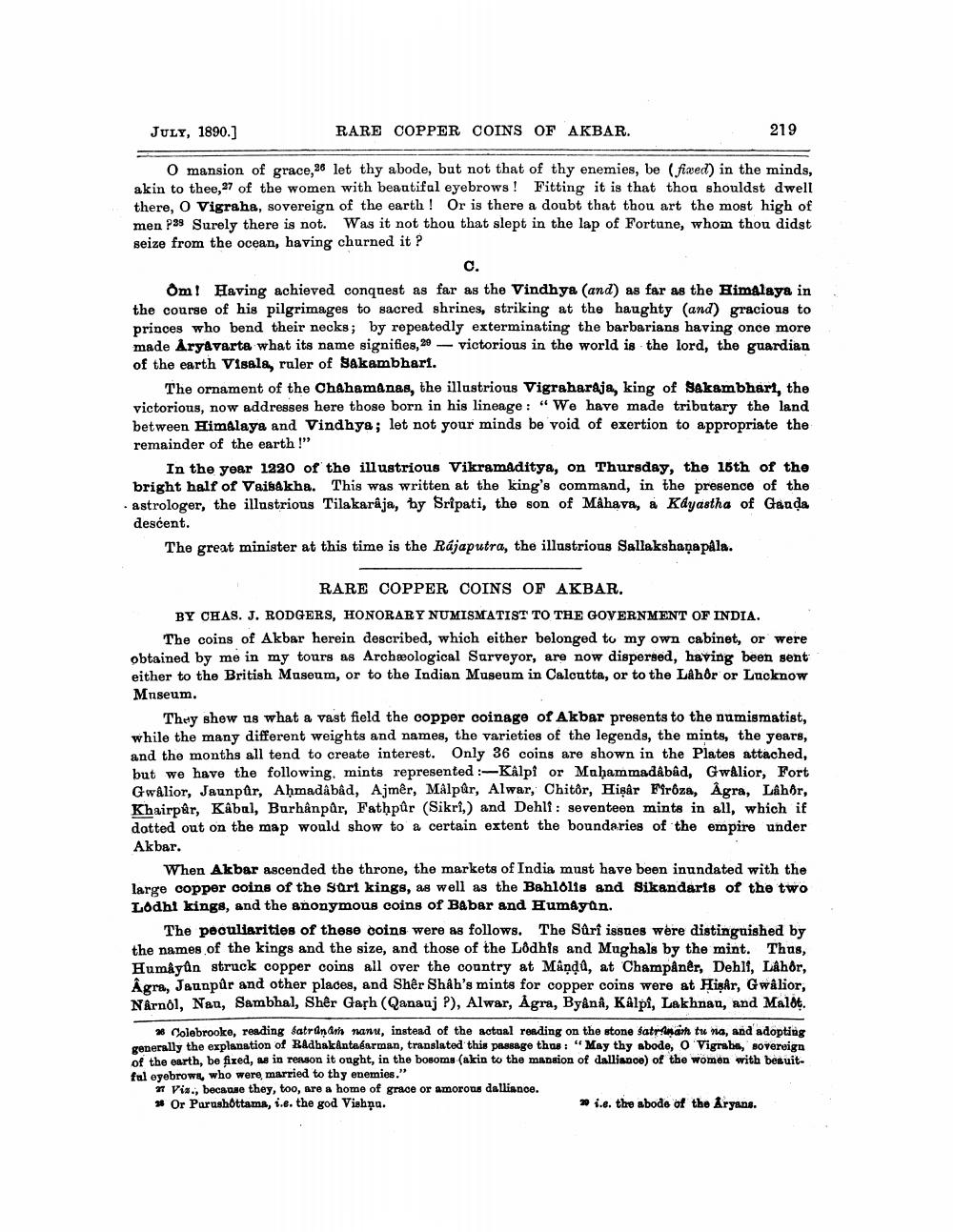________________
RARE COPPER COINS OF AKBAR.
JULY, 1890.]
O mansion of grace, 26 let thy abode, but not that of thy enemies, be (fixed) in the minds, akin to thee,27 of the women with beautiful eyebrows! Fitting it is that thou shouldst dwell there, O Vigraha, sovereign of the earth! Or is there a doubt that thou art the most high of men P23 Surely there is not. Was it not thou that slept in the lap of Fortune, whom thou didst seize from the ocean, having churned it ?
219
C.
Om! Having achieved conquest as far as the Vindhya (and) as far as the Himalaya in the course of his pilgrimages to sacred shrines, striking at the haughty (and) gracious to princes who bend their necks; by repeatedly exterminating the barbarians having once more made Aryavarta what its name signifies, 20 victorious in the world is the lord, the guardian of the earth Visala, ruler of Sakambhari.
The ornament of the Chahamanas, the illustrious Vigraharaja, king of Sakambhart, the victorious, now addresses here those born in his lineage: "We have made tributary the land between Himalaya and Vindhya; let not your minds be void of exertion to appropriate the remainder of the earth!"
In the year 1220 of the illustrious Vikramaditya, on Thursday, the 15th of the bright half of Vaisakha. This was written at the king's command, in the presence of the astrologer, the illustrious Tilakaraja, by Sripati, the son of Mahava, a Kayastha of Ganda descent.
The great minister at this time is the Rajaputra, the illustrious Sallakshanapala.
RARE COPPER COINS OF AKBAR.
BY CHAS. J. RODGERS, HONORARY NUMISMATIST TO THE GOVERNMENT OF INDIA. The coins of Akbar herein described, which either belonged to my own cabinet, or were obtained by me in my tours as Archæological Surveyor, are now dispersed, having been sent either to the British Museum, or to the Indian Museum in Calcutta, or to the Lâhôr or Lucknow Museum.
They show us what a vast field the copper coinage of Akbar presents to the numismatist, while the many different weights and names, the varieties of the legends, the mints, the years, and the months all tend to create interest. Only 36 coins are shown in the Plates attached, but we have the following. mints represented:-Kâlpi or Maḥammadâbâd, Gwalior, Fort Gwalior, Jaunpur, Aḥmadâbâd, Ajmêr, Malpûr, Alwar, Chitôr, Hisar Firóza, Agra, Lâhôr, Khairpur, Kabul, Burhanpûr, Fathpûr (Sikri,) and Dehli: seventeen mints in all, which if dotted out on the map would show to a certain extent the boundaries of the empire under Akbar.
When Akbar ascended the throne, the markets of India must have been inundated with the large copper coins of the Suri kings, as well as the Bahlolis and Sikandarts of the two Lodhi kings, and the anonymous coins of Babar and Humayan.
The peculiarities of these coins were as follows. The Sûrî issues were distinguished by the names of the kings and the size, and those of the Lôdhis and Mughals by the mint. Thus, Humayun struck copper coins all over the country at Mândû, at Champânêr, Dehli, Lâhôr, Agra, Jaunpur and other places, and Sher Shah's mints for copper coins were at Hisar, Gwalior, Nårnôl, Nau, Sambhal, Shêr Garh (Qanauj ?), Alwar, Agra, Byânâ, Kâlpi, Lakhnau, and Malot.
28 Colebrooke, reading satranam nanu, instead of the actual reading on the stone satranam tu na, and adopting generally the explanation of Radhakantaéarman, translated this passage thus: "May thy abode, O Vigraha, sovereign of the earth, be fixed, as in reason it ought, in the bosoms (akin to the mansion of dalliance) of the women with beauitful eyebrows, who were married to thy enemies."
27 Vis., because they, too, are a home of grace or amorous dalliance. 28 Or Purushottama, i.e. the god Vishnu.
i.e. the abode of the Aryans.




